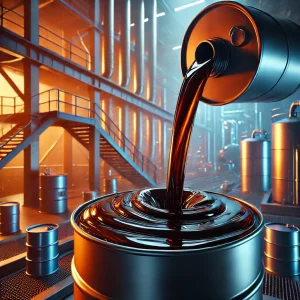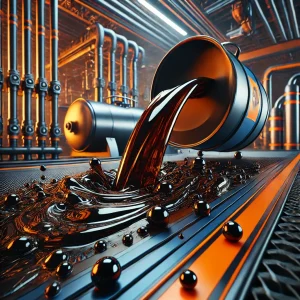



Fuel oil is a general term for various types of liquid petroleum products used primarily as a source of energy. It encompasses a range of products derived from crude oil through refining processes. These oils are used in different applications, including heating, transportation, and power generation.
Fuel oil refers to a category of refined petroleum products used as fuel in engines, furnaces, and industrial processes. It is derived from crude oil through various refining processes that separate and purify different components.
fuel oil refers to any liquid fuel that is used in a furnace/boiler to generate heat or in an engine to generate power, apart from those that have a flash point of around 42°C (108°F) and those that are burned in cotton or wood wick burners.
Types of Fuel Oil
Crude Oil
The unrefined oil extracted from underground reservoirs. It’s the raw material from which various refined products, including fuel oil, are derived.
Distillate Fuels
Diesel Fuel: Used in diesel engines for vehicles, trucks, and machinery. It’s a lighter, refined product with specific properties suited for internal combustion engines.
Heating Oil: Similar to diesel fuel but often with slight differences in additives and sulfur content. It’s used primarily for heating purposes in residential and commercial buildings.
Residual Fuels
Bunker Fuel: Used in marine engines and large industrial boilers. It’s a heavy, viscous fuel that includes various grades like Intermediate Fuel Oil (IFO) and Heavy Fuel Oil (HFO).
Heavy Fuel Oil (HFO): A very dense and viscous fuel used in power plants and large industrial facilities. It requires heating to flow and burn efficiently.
Blended Fuels
Mixtures of different fuel oils to achieve specific properties for particular applications.
Examples: Blends of lighter distillate fuels with heavier residual fuels to optimize performance and cost.
Properties of Fuel Oil
Viscosity
Low Viscosity: Easier to pump and handle, common in lighter distillate fuels like diesel.
High Viscosity: Heavier oils like heavy fuel oil (HFO) have high viscosity, requiring heating before they can flow properly or be burned efficiently.
Measurement: Typically measured in centistokes (cSt) at a specific temperature (usually 40°C).
Density
Denser fuel oils contain more energy per unit volume, which is important for energy-intensive applications.
Density affects how much energy can be stored in a given volume and impacts combustion characteristics.
Measurement: Measured using hydrometers or pycnometers at a standard temperature, often 15°C (59°F).
Sulfur Content
Environmental Impact: High sulfur content leads to greater emissions of sulfur dioxide (SO₂) during combustion, contributing to air pollution and acid rain.
Regulations: Many regions have strict limits on sulfur content in fuel oils, especially in marine fuels and heating oils.
Measurement: Determined through chemical analysis methods like X-ray fluorescence (XRF) or sulfur analyzers.
Flash Point
Safety: Fuels with lower flash points are more flammable and require careful handling and storage.
A higher flash point is generally safer, especially for storage and transport.
Measurement: Tested using standardized methods such as the Pensky-Martens Closed Cup test.
Pour Point
Cold Weather Performance: Determines the usability of the fuel in cold climates. Fuel oils with a high pour point may solidify in cold temperatures, necessitating additives or heating systems.
Storage and Handling: Critical for ensuring that the fuel remains usable in different temperature conditions.
Measurement: Determined by cooling the oil under controlled conditions and observing the temperature at which it ceases to flow.
Cetane Number
Higher cetane numbers indicate better combustion properties, leading to smoother engine operation, reduced emissions, and easier starting in cold conditions.
Critical for diesel engines, where the ignition quality directly affects performance.
Measurement: Determined using a standardized engine test.
Calorific Value (Heating Value)
A higher calorific value indicates more energy per unit of fuel, which is essential for power generation and heating applications.
Determines the efficiency of the fuel in producing energy.
Measurement: Measured using a bomb calorimeter.
Ash Content
High ash content can lead to fouling and corrosion in engines, boilers, and other equipment, reducing efficiency and increasing maintenance costs.
Indicates the presence of impurities in the fuel.
Measurement: Determined by burning a sample of fuel oil in a controlled environment and weighing the residue.
Water Content
Water in fuel oil can cause problems such as corrosion in storage tanks, microbial growth, and reduced combustion efficiency.
Excessive water content can lead to engine damage and operational issues in boilers and furnaces.
Measurement: Typically measured using the Karl Fischer titration method or centrifuge testing.
Carbon Residue
Indicates the tendency of the fuel to form deposits in engines and boilers during combustion.
High carbon residue can lead to increased maintenance and reduced efficiency.
Measurement: Measured using the Conradson Carbon Residue (CCR) test or the Micro Carbon Residue (MCR) test.
Acid Number
High acid numbers can indicate the presence of corrosive compounds that can damage storage tanks, pipes, and engines.
Used to assess the quality and stability of the fuel oil.
Measurement: Determined using a titration method.
Cloud Point
Important for fuel oils used in cold climates, as wax formation can clog filters and fuel lines.
Helps in determining the suitability of the fuel for use in lower temperatures.
Measurement: Observed visually as the oil is cooled under controlled conditions.
Distillation Range
Provides insight into the composition of the fuel oil, including the presence of light and heavy components.
Influences the combustion characteristics and volatility of the fuel.
Measurement: Determined through a distillation process, where the fuel is gradually heated and the boiling points of the different fractions are recorded.
Lubricity
Critical for diesel engines, where fuel lubricates injectors and other components.
Fuels with poor lubricity can cause increased wear and tear on engine parts.
Measurement: Assessed using standardized lubricity tests such as the High-Frequency Reciprocating Rig (HFRR) test.
Stability
Stable fuels remain usable over longer periods without degradation, which is important for storage and long-term use.
Unstable fuels can lead to operational problems and increased maintenance costs.
Measurement: Evaluated through tests that simulate long-term storage conditions and measure changes in fuel properties.
Usage
1.Transportation
Marine Vessels
Bunker Fuel: Fuel oil, particularly bunker fuel (such as Heavy Fuel Oil – HFO and Intermediate Fuel Oil – IFO), is widely used in the shipping industry to power marine vessels. These fuels provide the high energy density needed for large ships, including cargo ships, tankers, and container ships, allowing them to operate efficiently over long distances.
Marine Diesel Oil (MDO): A lighter fuel oil used in smaller vessels and for auxiliary engines on larger ships.
Diesel Engines
Automobiles and Trucks: Diesel fuel, a type of distillate fuel oil, is used in diesel engines found in cars, trucks, buses, and other vehicles. Diesel engines are favored for their fuel efficiency, durability, and ability to generate more torque, making them ideal for heavy-duty transportation.
Railways: Diesel fuel powers locomotives in rail transportation, providing a reliable and energy-efficient alternative to electric trains, especially in regions without electrified tracks.
2.Heating
Residential Heating
Heating Oil: In many parts of the world, particularly in colder climates, fuel oil is used for heating homes. Heating oil is typically stored in tanks and used in furnaces or boilers to generate heat. It is especially common in regions where natural gas is not readily available.
Kerosene: A lighter distillate fuel used in portable heaters and some residential heating systems, particularly in rural or off-grid locations.
Commercial Heating
Boilers and Furnaces: Fuel oil is used in larger boilers and furnaces for heating commercial buildings, schools, hospitals, and industrial facilities. It provides consistent and reliable heating, particularly in areas where natural gas infrastructure is lacking.
3.Power Generation
Electricity Generation
Power Plants: Fuel oil is burned in power plants to generate electricity, particularly in regions where other energy sources like coal, natural gas, or renewables are less available or less cost-effective. Heavy Fuel Oil (HFO) is often used in large-scale power generation.
Peaking Power Plants: Fuel oil can be used in peaking power plants that operate during periods of high electricity demand, providing additional capacity when needed.
Backup Power
Generators: Fuel oil is commonly used in backup generators to ensure continuous power supply in critical infrastructure, such as hospitals, data centers, and military facilities. These generators kick in during power outages to maintain essential operations.
4.Industrial Processes
Boilers and Furnaces
Industrial Heating: Fuel oil is used in industrial boilers and furnaces to generate the high temperatures needed for various manufacturing processes. This includes applications like metalworking, cement production, and chemical processing.
Steam Generation: Many industries use fuel oil to generate steam, which is then used for heating, sterilization, and as a driving force in various mechanical processes.
Asphalt Production
Hot Mix Plants: Fuel oil is used to heat and mix the materials needed to produce asphalt, which is then used in road construction and maintenance. The high temperatures provided by fuel oil are necessary to achieve the proper consistency and quality of asphalt.
5.Marine and Aviation Fuel
Marine Fuel
Large Vessels: In addition to bunker fuel, other types of marine fuel oils like Marine Diesel Oil (MDO) and Marine Gas Oil (MGO) are used in the shipping industry for different types of vessels and auxiliary engines.
Aviation Fuel
Kerosene-Based Jet Fuel: While not traditionally categorized as fuel oil, kerosene-based jet fuels (like Jet-A) are refined from similar distillate products. These fuels power commercial aircraft and military jets due to their high energy content and stability at varying altitudes and temperatures.
6.Agricultural and Construction Machinery
Tractors and Heavy Equipment
Diesel Engines: Fuel oil, specifically diesel, is used to power tractors, harvesters, and other agricultural machinery, providing the necessary power and efficiency for farming operations.
Construction Machinery: Heavy construction equipment such as bulldozers, excavators, and cranes rely on diesel fuel for their operation, allowing them to perform demanding tasks in construction and infrastructure development.
7.Military Applications
Vehicles and Equipment
Military Vehicles: Armored vehicles, tanks, and other military machinery use diesel fuel for their engines, benefiting from the fuel’s energy density and reliability under challenging conditions.
Field Generators: Fuel oil is used in mobile generators and other equipment in military operations, ensuring power supply in remote or combat areas.
8.Petrochemical Feedstock
Chemical Production
Feedstock: Certain types of fuel oil can be used as a feedstock in the petrochemical industry to produce various chemicals, plastics, and synthetic materials.
Steam Cracking: In processes like steam cracking, lighter fractions of fuel oil are used to produce ethylene, propylene, and other important chemical building blocks.
9.Environmental Remediation
Oil Spill Response
Burning in Situ: In some cases, fuel oil is used as part of controlled burns to clean up oil spills in marine environments. The oil is ignited on the surface of the water to reduce the volume of the spill, although this method is used sparingly due to environmental concerns.
10.Alternative and Emergency Fuel
Emergency Fuel Supply
Critical Infrastructure: In emergencies where natural gas or electricity supplies are disrupted, fuel oil serves as an alternative energy source, particularly for heating and power generation in critical facilities.
Remote Areas
Off-Grid Applications: In remote areas without access to other fuels, fuel oil remains a vital energy source for heating, electricity, and industrial processes.